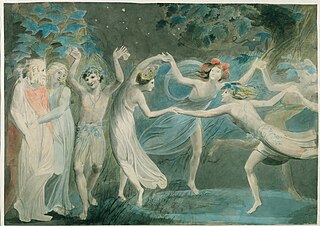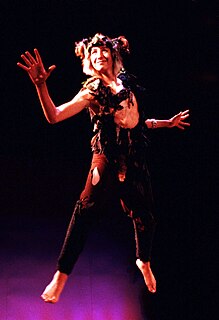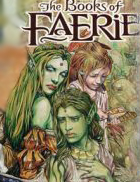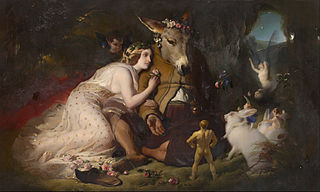
A Midsummer Night's Dream is a comedy written by William Shakespeare c. 1595 or 1596. The play is set in Athens, and consists of several subplots that revolve around the marriage of Theseus and Hippolyta. One subplot involves a conflict among four Athenian lovers. Another follows a group of six amateur actors rehearsing the play which they are to perform before the wedding. Both groups find themselves in a forest inhabited by fairies who manipulate the humans and are engaged in their own domestic intrigue. The play is one of Shakespeare's most popular and is widely performed.

Puck, or Robin Goodfellow, is a character in William Shakespeare's play, A Midsummer Night's Dream.

Oberon is a king of the fairies in medieval and Renaissance literature. He is best known as a character in William Shakespeare's play A Midsummer Night's Dream, in which he is King of the Fairies and spouse of Titania, Queen of the Fairies.

The mechanicals are six characters in A Midsummer Night's Dream who perform the play-within-a-play Pyramus and Thisbe. They are a group of amateur and mostly incompetent actors from around Athens, looking to make names for themselves by having their production chosen among several acts as the courtly entertainment for the royal wedding party of Theseus and Hippolyta. The servant-spirit Puck describes them as "rude mechanicals" in Act III, Scene 2 of the play, in reference to their occupations as skilled manual laborers.

Titania, also designated Uranus III, is the largest of the moons of Uranus and the eighth largest moon in the Solar System at a diameter of 1,578 kilometres (981 mi). Discovered by William Herschel in 1787, it is named after the queen of the fairies in Shakespeare's A Midsummer Night's Dream. Its orbit lies inside Uranus's magnetosphere.

Titania is a fictional character, a comic book faerie published by DC Comics. She first appeared in The Sandman #19, and was created by Neil Gaiman and Charles Vess. She is inspired by and implied to be the same as Titania as the faerie queen in William Shakespeare's play A Midsummer Night's Dream.

Uranus, the seventh planet of the Solar System, has 27 known moons, most of which are named after characters that appear in, or are mentioned in, the works of William Shakespeare and Alexander Pope. Uranus's moons are divided into three groups: thirteen inner moons, five major moons, and nine irregular moons. The inner and major moons all have prograde orbits, while orbits of the irregulars are mostly retrograde. The inner moons are small dark bodies that share common properties and origins with Uranus's rings. The five major moons are ellipsoidal, indicating that they reached hydrostatic equilibrium at some point in their past, and four of them show signs of internally driven processes such as canyon formation and volcanism on their surfaces. The largest of these five, Titania, is 1,578 km in diameter and the eighth-largest moon in the Solar System, about one-twentieth the mass of the Earth's Moon. The orbits of the regular moons are nearly coplanar with Uranus's equator, which is tilted 97.77° to its orbit. Uranus's irregular moons have elliptical and strongly inclined orbits at large distances from the planet.

Nick Bottom is a character in Shakespeare's A Midsummer Night's Dream who provides comic relief throughout the play. A weaver by trade, he is famously known for getting his head transformed into that of a donkey by the elusive Puck. Bottom and Puck are the only two characters who converse with and progress the three central stories in the whole play. Puck is first introduced in the fairies' story and creates the drama of the lovers' story by messing up who loves whom, and places the donkey head on Bottom's in his story. Similarly, Bottom is performing in a play in his story intending it to be presented in the lovers' story, as well as interacting with Titania in the fairie's story.

Titania is a character in William Shakespeare's 1595–1596 play A Midsummer Night's Dream.

A Midsummer Night's Dream is a 1999 romantic comedy fantasy film based on the play of the same name by William Shakespeare. It was written, directed and co-produced by Michael Hoffman. The ensemble cast features Kevin Kline as Bottom, Michelle Pfeiffer and Rupert Everett as Titania and Oberon, Stanley Tucci as Puck, and Calista Flockhart, Anna Friel, Christian Bale, and Dominic West as the four lovers.

A Midsummer Night's Dream is a 1935 American romantic comedy fantasy film of William Shakespeare's play, directed by Max Reinhardt and William Dieterle, and starring James Cagney, Mickey Rooney, Olivia de Havilland, Jean Muir, Joe E. Brown, Dick Powell, Ross Alexander, Anita Louise, Victor Jory and Ian Hunter. Produced by Henry Blanke and Hal B. Wallis for Warner Brothers, and adapted by Charles Kenyon and Mary C. McCall Jr. from Reinhardt's Hollywood Bowl production of the previous year, the film is about the events surrounding the marriage of the Duke of Athens, Theseus, and the Queen of the Amazons, Hippolyta. These include the adventures of four young Athenian lovers and a group of six amateur actors, who are controlled and manipulated by the fairies who inhabit the forest in which most of the story is set. The play, which is categorized as a comedy, is one of Shakespeare's most popular works for the stage and is widely performed across the world. Felix Mendelssohn's music was extensively used, as re-orchestrated by Erich Wolfgang Korngold. The ballet sequences featuring the fairies were choreographed by Bronislava Nijinska.

A Midsummer Night's Dream is a 1909 American film directed by Charles Kent and J. Stuart Blackton, and starring Walter Ackerman and Charles Chapman. It was the first film adaptation of the eponymous play by William Shakespeare. The movie was made during summer 1909, but not released until 25 December.

Faerie, The Fair Lands or The Twilight Realm is one of two fictional otherdimensional homelands for the Faerie, as published by DC Comics. The Vertigo Comics realm of Faerie is an amalgam of the mythological realms of Álfheimr, Otherworld, the Fortunate Isles, Tír na nÓg and Avalon. This mix is heavily influenced by Shakespeare's play A Midsummer Night's Dream. It is home to the faeries and other mythical races, ruled over by the Seelie Court and King Auberon and Queen Titania. Faerie debuted in The Books of Magic #3, and was created by Neil Gaiman and Charles Vess.

Gertrude is the largest known crater on Uranus's moon Titania. It is about 326 km across, 1/5 of Titania's diameter. It is named after the mother of Hamlet in William Shakespeare's play Hamlet. Features on Titania are named after female Shakespearean characters.

The Messina Chasmata are the largest canyon or system of canyons on the surface of the Uranian moon Titania, named after a location in William Shakespeare's comedy Much Ado About Nothing. The 1,492 km (927 mi)- long feature includes two normal faults running NW–SE, which bound a down-dropped crustal block forming a structure called a graben. The graben cuts impact craters, which probably means that it was formed at a relatively late stage of the moon's evolution, when the interior of Titania expanded and its ice crust cracked as a result. The Messina Chasmata have only a few superimposed craters, which also implies being relatively young. The feature was first imaged by Voyager 2 in January 1986.

The 1970 Royal Shakespeare Company (RSC) production of A Midsummer Night's Dream was directed by Peter Brook, and is often known simply as Peter Brook'sDream. It opened in the Royal Shakespeare Theatre at Stratford-upon-Avon and then moved to the Aldwych Theatre in London's West End in 1971. It was taken on a world tour in 1972–1973. Brook's production of A Midsummer Night's Dream for the RSC is often described as one of the 20th century's most influential productions of Shakespeare, as it rejected many traditional ideas about the staging of classic drama.

The Fairy Queen or Queen of the Fairies is a figure from Irish and British folklore, believed to rule the fairies. Based on Shakespeare's influence, in English-speaking cultures she is often named Titania or Mab.

Scene from A Midsummer Night's Dream. Titania and Bottom is an 1851 oil-on-canvas painting by British artist Edwin Landseer. Landseer was mainly known for his paintings of animals: this is his only painting of a fairy scene. The painting depicts a scene from the third act of William Shakespeare's play A Midsummer Night's Dream. It has been in the collection of the National Gallery of Victoria in Melbourne, Australia since 1932.
Titania McGrath (@TitaniaMcGrath) is a parody Twitter account created and run by Andrew Doyle, a British comedian and Spiked columnist. Doyle describes her as "a militant vegan who thinks she is a better poet than William Shakespeare". As of March 2021, the character has more than 600,000 followers. Using this pseudonym, Doyle wrote a book, Woke: A Guide to Social Justice, which was published on 7 March 2019. His second book under the name, My First Little Book of Intersectional Activism, was published in September 2020. He also created a live comedy show featuring Titania, which debuted at the Edinburgh Festival Fringe in August 2019.

Titania and Bottom is an oil painting by the Anglo-Swiss painter Henry Fuseli. It dates to around 1790 and is displayed at Tate Britain in London. It was commissioned for the Boydell Shakespeare Gallery and depicts a scene from A Midsummer Night's Dream by William Shakespeare.